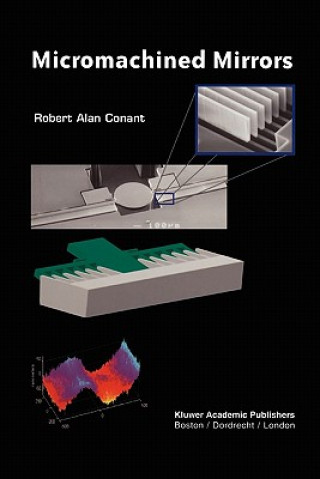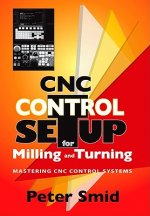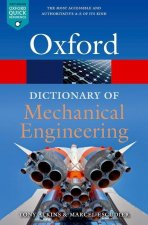
Kód: 01423631
Micromachined Mirrors
Autor Robert Conant
Micromachined Mirrors provides an overview of the performance enhancements that will be realized by miniaturizing scanning mirrors like those used for laser printers and barcode scanners, and the newly enabled applications, includ ... celý popis
- Jazyk:
 Angličtina
Angličtina - Väzba: Brožovaná
- Počet strán: 139
Nakladateľ: Springer, Berlin, 2010
- Viac informácií o knihe

138.31 €

Skladom u dodávateľa v malom množstve
Odosielame za 12 - 15 dní
Potrebujete viac kusov?Ak máte záujem o viac kusov, preverte, prosím, najprv dostupnosť titulu na našej zákazníckej podpore.
Pridať medzi želanie
Mohlo by sa vám tiež páčiť
-

Fictions of the Bad Life
51.44 € -

Rescue of the Princess Winsome a Fairy Play for Old and Young
10.04 € -

Patent Markets in the Global Knowledge Economy
159.02 € -

Game of Mix and Match
10.75 € -3 % -

Matematika pro 4. ročník ZŠ Metodická příručka
5.67 € -

Kniha džunglí
7.70 € -22 % -

Město Podívej se pod okénko!
3.44 € -27 %
Darujte túto knihu ešte dnes
- Objednajte knihu a vyberte Zaslať ako darček.
- Obratom obdržíte darovací poukaz na knihu, ktorý môžete ihneď odovzdať obdarovanému.
- Knihu zašleme na adresu obdarovaného, o nič sa nestaráte.
Viac informácií o knihe Micromachined Mirrors
Nákupom získate 345 bodov
 Anotácia knihy
Anotácia knihy
Micromachined Mirrors provides an overview of the performance enhancements that will be realized by miniaturizing scanning mirrors like those used for laser printers and barcode scanners, and the newly enabled applications, including raster-scanning projection video displays and compact, high-speed fiber-optic components. There are a wide variety of methods used to fabricate micromachined mirrors - each with its advantages and disadvantages. There are, however, performance criteria common to mirrors made from any of these fabrication processes. For example, optical resolution is related to the mirror aperture, the mirror flatness, and the scan angle. Micromachined Mirrors provides a framework for the design of micromirrors, and derives equations showing the fundamental limits for micromirror performance. These limits provide the micromirror designer tools with which to determine the acceptable mirror geometries, and to quickly and easily determine the range of possible mirror optical resolution and scan speed.Micromachined scanning mirrors are interesting for a wide variety of applications because of their potential low cost, high speed, low power consumption, and reliability. These mirrors can offer significant advantages over macro-scale mirrors, but the fundamental limitations of scanning mirrors have not been widely discussed. Miniaturization in electronic systems has led to radical improvements in computers and communications, and micromachining technologies promise to generate such improvements in miniaturized mechanical and optical systems, including specifically higher-speed, smaller, lower-cost scanning mirrors. Micromachined Mirrors provides an overview of the performance enhancements that will be realized by miniaturizing scanning mirrors like those used for laser printers and barcode scanners, and the newly enabled applications, including raster-scanning projection video displays and compact, high-speed fiber-optic components. There are a wide variety of methods used to fabricate micromachined mirrors - each with its advantages and disadvantages. There are, however, performance criteria common to mirrors made from any of these fabrication processes. For example, optical resolution is related to the mirror aperture, the mirror flatness, and the scan angle. Micromachined Mirrors provides a framework for the design of micromirrors, and derives equations showing the fundamental limits for micromirror performance. These limits provide the micromirror designer tools with which to determine the acceptable mirror geometries, and to quickly and easily determine the range of possible mirror optical resolution and scan speed. Micromachined Mirrors presents descriptions of mirrors made from two fabrication processes - the surface-micromachining process and the staggered torsional electrostatic combdrive (STEC) high-aspect ratio micromachining process. The mirrors made using these two processes are evaluated for scan speed, optical resolution, ease of manufacture, and reliability. Micromachined Mirrors also presents an example application of surface-micromachined mirrors: a raster-scanning projection video display. This demonstration shows the advantages of micromachined mirrors (small high-speed scanners) with special attention paid to the major drawback of surface-micromachined mirrors (lower resolution due to dynamic deformation). The successful demonstration of this simple prototype video display helps clarify the importance of the critical performance characteristics to consider when designing micromachined mirrors.
 Parametre knihy
Parametre knihy
Zaradenie knihy Knihy po anglicky Technology, engineering, agriculture Mechanical engineering & materials Mechanical engineering
138.31 €
- Celý názov: Micromachined Mirrors
- Autor: Robert Conant
- Jazyk:
 Angličtina
Angličtina - Väzba: Brožovaná
- Počet strán: 139
- EAN: 9781441953254
- ISBN: 1441953256
- ID: 01423631
- Nakladateľ: Springer, Berlin
- Hmotnosť: 254 g
- Rozmery: 8 × 155 × 8 mm
- Rok vydania: 2010
Obľúbené z iného súdka
-

Kaw Vulcan 800 & Classic 95-05
40.48 € -16 % -

Automating with SIMATIC S7-1200 3e - Configuring, Programming and Testing with STEP 7
80.36 € -

Weber/Zenith Stromberg/Su Carburetor Manual
41.09 € -10 % -

Compliant Mechanisms
180.73 € -

Internal Combustion Engine Fundamentals 2E
176.57 € -

CNC Setup for Milling and Turning
123.39 € -

Honda CB900-1100 Fours 80-83
51.44 € -16 % -

Machine and Industrial Design in Mechanical Engineering
76.41 € -

Materials Selection in Mechanical Design
64.43 € -

Suzuki Vs1400 Intruder/Boulevard S83 1987-2007
43.53 € -10 % -

Tunisian Crochet
25.67 € -1 % -

Mastermyr Find
16.53 € -13 % -

Building Simple Model Steam Engines
8.92 € -23 % -

Mechanics of Materials, SI Edition
99.44 € -

Stirling Engine Design Manual
47.99 € -

Manufacturing Engineering Handbook, Second Edition
230.97 € -

Contemporary Irish Knitting
29.62 € -4 % -

Developing Safety-Critical Software
118.32 € -

Engine Modeling and Control
175.56 € -

Clymer Harley-Davidson FXD Twin Cam 88
43.53 € -10 % -

How to Be Chic and Elegant
12.68 € -

Heat Pump Fundamentals
70.22 € -

Invariantive Mechanics
70.22 € -

Dictionary of Mechanical Engineering
17.24 € -20 % -

Jet Engine 5e
73.67 € -

507 Mechanical Movements
12.57 € -4 % -

How to Repair Briggs and Stratton Engines, 4th Ed.
23.43 € -9 % -

How Patterns Work
32.67 € -

CNC Machining Handbook: Building, Programming, and Implementation
42.82 € -13 % -

Freeform Knitting and Crochet
26.07 € -

Building a Portable Steam Engine
24.14 € -14 % -

Jet Engines
24.14 € -15 % -

Make - Rockets
32.97 € -19 % -

English for Mechanical Engineering Course Book + CDs
33.99 € -

Lean Maintenance Repair and Overhaul
72.75 € -

Corrosion for Everybody
118.32 € -

Getting Started with CNC
20.69 € -20 % -

Durability of Building Materials and Components
138.31 € -

Two-Stroke Engine Repair and Maintenance
23.84 € -8 % -

Modern Steam Engines
19.68 € -

Theory of Machines and Mechanisms
158.71 € -

Quick & Easy Quilts for Kids
9.02 € -19 % -

Design of Experiments for Engineers and Scientists
64.03 € -5 % -

String Theory Demystified
31.96 € -

With Fabric & Thread
37.23 € -3 % -

Inside Rhinoceros 5
135.37 € -

HÜTTE Set: Grundlagen für Ingenieure
209.96 € -

Gas Turbine Engineering Handbook
195.35 € -

Rowans Greatest Knits
29.32 €
Osobný odber Bratislava a 2642 dalších
Copyright ©2008-24 najlacnejsie-knihy.sk Všetky práva vyhradenéSúkromieCookies


 21 miliónov titulov
21 miliónov titulov Vrátenie do mesiaca
Vrátenie do mesiaca 02/210 210 99 (8-15.30h)
02/210 210 99 (8-15.30h)